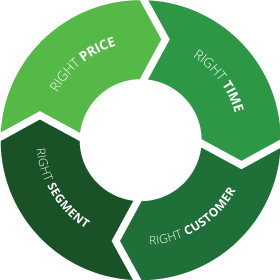
There is no question digitization is changing today’s enterprise. Growing commoditization, easily accessible technology and the ever expanding volume of big data are just a few of the complexities driving the need for change today. And if these mega trends aren’t effectively turning the heads of today’s B2B organizations fast enough to cause whiplash, growing customer experience expectations and changing buyer habits will. Digital disruption is the name of the game in today’s B2B marketplace and organizations must do business differently.
This shift has also impacted Configure-Price-Quote (CPQ) systems. Since it first launched nearly 30 years ago, CPQ has been critically important for sales organizations, particularly those that offer really complex product lines. But like every other facet of B2B, CPQ must evolve to meet the needs of our digital economy.
Early versions of CPQ solutions emphasized configuration so sales could combine products into customer-specific bundles. At the time, it was smart, even revolutionary thinking. More recently, CPQ models evolved to utilize advanced configuration and quoting processes which again, was of significant benefit to the sales process and, when done right, to the sellers’ bottom line. Unfortunately, CPQ was ignoring what is arguably the most important deal lever – price.
By retaining the use of standard, rarely updated price lists, traditional CPQ systems weren’t doing the heavy lifting organizations needed to answer the call to be more intelligent at every turn. At most, sales reps could simply enter a price that they thought would win – without any context other than what they carried around in their heads.

Modern CPQ solutions should equip selling channels with the best buying experience. They also must deliver the right price at the right time to the right customer. Price optimization integrated into your CPQ processes allows you to open up massive profit opportunities through a faster time-to-quote, increased profitability on a deal-by-deal basis, and an improved, specialized customer experience.
Consider this: traditionally, businesses would bundle products based on cross-sell opportunities or where the products fit on the spectrum of Pick-to-Order, Assemble-to-Order, Make-to-Order, or Engineer-to-Order. Products would be assigned a standard price (based primarily on cost) and sales would then try to generate a quote to fit the customer’s needs as well as the margin needs of their own organization. Nothing about this process speaks to intelligent business – or understanding what the customer actually values. In fact, handcuffed quoting like this often leads to over-discounting and volume-driven sales tactics.
If you’re currently using CPQ for the configuration and quote benefits, kudos to you and your team. But if you aren’t factoring in optimized price, you’re likely disappointing your customers and leaving a lot of money on the table.
For details on how to set the right CPQ strategy for your organization and extract the most value, listen to this short webinar.
